Modern wearables track your sleep recovery through multiple biometric sensors that measure heart rate variability, body temperature, and movement patterns throughout the night. Your HRV data reveals how well your autonomic nervous system recovers from daily stress, while advanced devices like WHOOP and Oura Ring combine accelerometers with PPG sensors to detect sleep stages with 74-86% accuracy against clinical standards. These metrics help you understand whether you’re truly recovering or accumulating sleep debt that could impact your performance and health.
How Wearable Sensors Monitor Sleep Patterns and Recovery
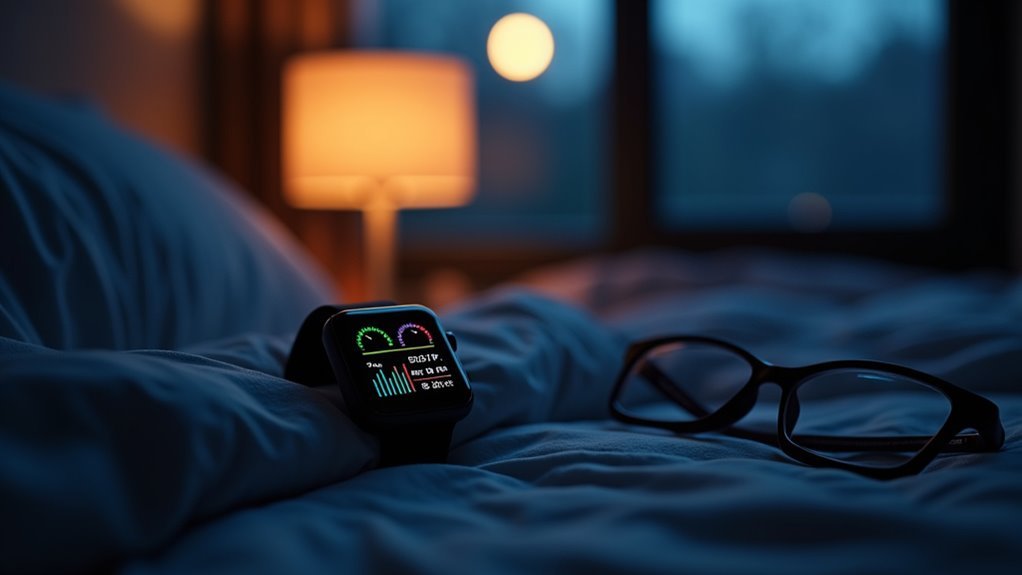
As sleep research has evolved from laboratory-based studies to consumer-accessible technology, wearable sensors have transformed how you can monitor your sleep patterns and recovery at home.
First-generation devices relied on accelerometers to detect movement, similar to clinical actigraphy, but they struggled with wake detection during stillness periods.
Today’s advanced wearables combine multiple sensors—motion detectors, heart rate monitors, skin temperature sensors, and respiratory trackers—to provide thorough sleep analysis.
You’ll find wrist-based devices offer convenience, while chest sensors excel at breathing pattern monitoring and smart rings reduce movement artifacts.
These multisensory approaches enable detailed sleep stage estimation, tracking light, deep, and REM phases throughout the night, giving you unprecedented insights into your recovery patterns. However, consumer sleep technologies are not yet suitable for diagnosing clinical sleep disorders like obstructive sleep apnea.
Heart Rate Variability as a Key Recovery Indicator
Your wearable device measures heart rate variability by tracking the tiny variations between consecutive heartbeats during sleep, providing essential insights into your autonomic nervous system’s balance.
This HRV data reveals whether you’ve truly recovered from previous day’s stress and training, helping you interpret your body’s readiness for another demanding day. WHOOP members demonstrate that adequate sleep for optimal recovery requires an average of 7:11 hours of actual sleep duration nightly.
Understanding how to apply these HRV patterns to your training decisions can prevent overexertion and optimize your performance by showing when you’re primed for intensity versus when you need rest.
HRV Measurement Technology
When you’re tracking sleep recovery, heart rate variability (HRV) stands out as one of the most reliable indicators of how well your body’s bouncing back from daily stressors.
Modern wearables use sophisticated technology to measure the tiny variations between your heartbeats, reflecting your autonomic nervous system’s function.
Most devices calculate HRV using Root Mean Square of Successive Differences (RMSSD), which standardizes measurements across different brands.
Smartwatches, fitness bands, and under-mattress sensors like EMFIT QS capture this data continuously during sleep, when your readings are most stable and accurate.
These devices validate their measurements against clinical ECG standards, showing strong correlations.
The technology combines HRV with accelerometry to enhance sleep stage detection, giving you thorough recovery insights. Higher HRV scores generally indicate improved vagal tone and better autonomic regulation, which correlates with enhanced recovery capacity.
Recovery Status Interpretation
Understanding your HRV readings requires looking beyond the raw numbers to grasp what they’re actually telling you about your body’s recovery state. Higher HRV generally indicates better autonomic nervous system balance and improved recovery from exercise, but you can’t interpret these values in isolation.
Your individual baseline matters more than comparing yourself to population averages, since factors like age, sex, and recording conditions affect your personal norms.
You’ll need to track trends over time rather than focusing on single measurements. A declining HRV pattern often signals accumulated stress or inadequate recovery, while rising trends suggest your body’s adapting well.
Don’t assume higher is always better—dramatic spikes can indicate overcompensation. Since HRV typically decreases with age, you should adjust your expectations and baseline measurements accordingly as you get older. Context matters: consider your sleep quality, training load, and daily stressors when interpreting changes.
Training Readiness Applications
HRV data becomes most valuable when you apply it to make real-time training decisions rather than simply tracking numbers after the fact.
When your HRV readings show high variability, it indicates balanced autonomic function and signals you’re ready for intense training sessions. Conversely, consistently low HRV suggests your body hasn’t fully recovered, making it wise to reduce intensity or focus on active recovery.
Your wearable device can guide these decisions by alerting you to concerning patterns before they lead to overtraining. High HRV demonstrates better adaptability to physical demands, while declining trends warn of accumulated fatigue. For the most accurate baseline measurements, track your HRV during sleep cycles when environmental stressors don’t influence the readings.
Sleep Stage Detection Through Motion and Biometric Analysis
Although traditional fitness trackers relied solely on movement patterns to estimate sleep quality, today’s advanced wearables incorporate multiple biometric sensors to detect distinct sleep stages with increasing precision.
Your device now combines accelerometers, photoplethysmography (PPG) sensors, and temperature monitors to analyze heart rate variability, pulse patterns, and body movement simultaneously.
While accelerometry alone achieves 70-85% accuracy for basic wake-sleep detection, it can’t distinguish between sleep phases. PPG sensors improve stage identification but struggle with certain changes.
The most accurate consumer devices integrate EEG sensors in headbands or earbuds, reaching 74-86% agreement with clinical sleep studies across all stages: wake, light sleep (N1, N2), deep sleep (N3), and REM.
Multi-sensor approaches reduce error margins while maintaining comfortable wearability for nightly use. However, proprietary algorithms used by many consumer-grade devices often lack transparency, which researchers emphasize as a significant concern for reliability assessment.
Comparing Wearable Accuracy Against Clinical Sleep Studies
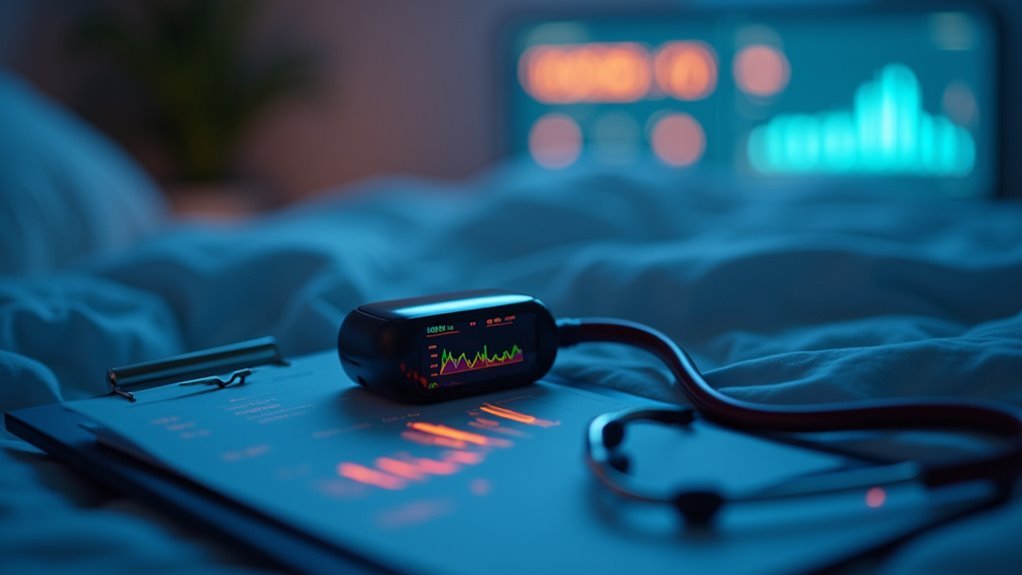
When researchers evaluate how well your wearable performs against polysomnography (PSG)—the clinical gold standard—they’re measuring more than simple accuracy percentages.
They’re appraising whether your device can reliably detect sleep stages and total sleep time in controlled laboratory settings where every brain wave is monitored.
Current validation studies reveal significant performance gaps:
- Oura Ring Gen3 and Fitbit Sense 2 show improved sleep stage detection compared to earlier generations.
- Phillips Actiwatch and Garmin Vivosmart consistently overestimate total sleep time versus PSG measurements.
- Apple Watch Series 8 demonstrates competitive accuracy when evaluated alongside leading sleep trackers.
- Dreem 2 receives high user accuracy ratings, though clinical validation varies.
While your wearable won’t match PSG’s precision, these comparative studies help you understand your device’s limitations and strengths. Most consumer devices show proportional bias patterns where they overestimate shorter wake periods and underestimate longer wake times, affecting overall sleep measurement accuracy.
WHOOP Strain and Recovery Metrics for Athletic Performance
WHOOP’s recovery algorithm stands out by combining multiple physiological markers—including heart rate variability, resting heart rate, and sleep metrics—to generate a personalized daily recovery percentage that directly indicates your readiness for athletic performance.
You’ll receive color-coded feedback (green, yellow, or red) that tells you whether you’re prepared for high-intensity training or need to prioritize rest and recovery.
This system’s accuracy in predicting training readiness has made it particularly valuable for athletes who need precise data to optimize their performance while avoiding overtraining. Users can access comprehensive support resources through the app to troubleshoot any issues and maximize their device’s functionality.
WHOOP Recovery Algorithm Accuracy
The precision of WHOOP’s recovery algorithm hinges on its sophisticated data collection methods, which continuously monitor heart rate variability, sleep patterns, and strain data to calculate your body’s readiness for performance.
This continuous assessment guarantees you’re getting accurate insights into your physiological state.
The algorithm’s accuracy stems from four key mechanisms:
- Sleep debt monitoring – Tracks accumulated sleep deficiency and recent naps to adjust recovery calculations
- Physiological adaptation tracking – Modifies scores based on your body’s adaptation to stress over time
- User feedback integration – Incorporates your activity adjustments to calibrate future recommendations
- Continuous data refinement – Updates regularly with your personal data to improve predictive accuracy
This multi-layered approach helps you make informed decisions about training intensity and recovery needs. The system provides color-coded results in green, yellow, or red categories to instantly communicate your recovery status each morning.
Athletic Training Readiness Scores
Understanding your athletic readiness requires more than just tracking individual workouts—it demands an extensive view of how your body responds to accumulated stress and recovers between training sessions.
WHOOP’s Recovery Score provides exactly this insight through color-coded readiness levels. Green recovery (67-99%) signals you’re prepared for high-intensity training, while yellow (34-66%) suggests moderating your activity levels. Red recovery (1-33%) indicates your body needs rest or light movement only.
Your strain accumulation isn’t linear—it considers all daily activities, from intense workouts to work stress. WHOOP’s Strain Coach displays your total daily strain and provides real-time coaching cues to help optimize your training decisions.
The technology combines heart rate variability, sleep quality, and cardiovascular load data to generate actionable training recommendations. This data-driven approach helps you balance strain and recovery, preventing overtraining while optimizing performance timing.
Garmin Training Readiness Integration With Sleep Data
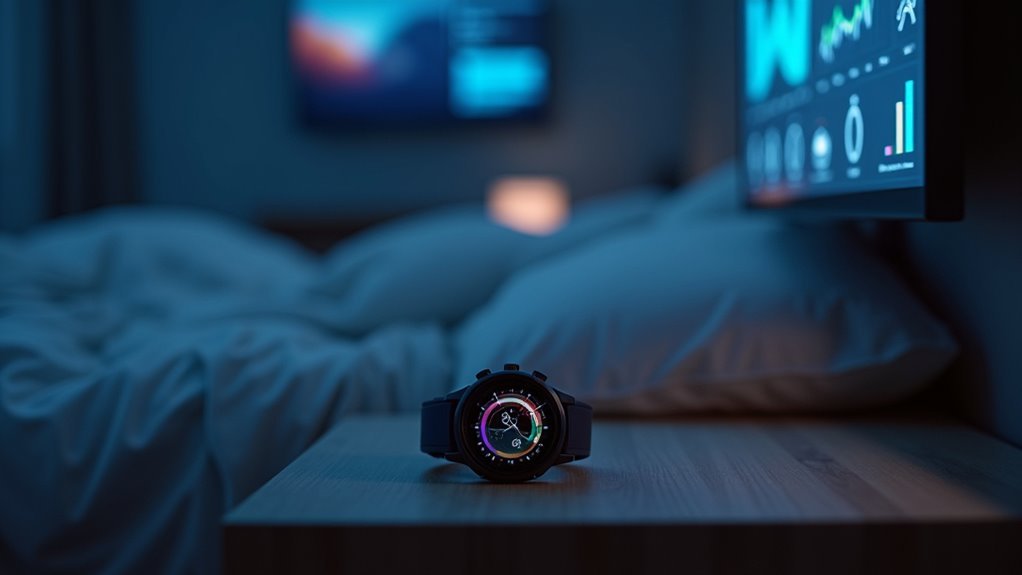
Garmin’s Training Readiness metric represents a sophisticated approach to workout planning by weaving together multiple physiological indicators into a single, actionable score. Your device analyzes sleep quality from previous nights, combining this data with heart rate variability, recovery time, and recent workout intensity to determine whether you’re prepared for demanding exercise.
The integration works through four key components:
- Sleep Score Analysis – Evaluates your previous night’s sleep quality and duration
- HRV Status Monitoring – Measures stress levels and recovery through heart rate variability
- Recovery Time Calculation – Determines how much rest you need from recent activities
- Acute Load Assessment – Analyzes your recent workout intensity and volume
You’ll receive color-coded readiness zones that provide visual guidance for making informed training decisions based on your body’s current state. For multi-device users, TrueUp and Physio TrueUp must be activated to ensure proper data synchronization between your Garmin devices.
Fitbit Sleep Tracking Validation and Performance Results
When you’re evaluating Fitbit’s sleep tracking capabilities, you’ll find that sleep onset detection consistently underestimates your actual sleep onset latency by 1.8 to 23 minutes compared to clinical polysomnography standards.
Your device’s sleep stage classification performance varies considerably depending on which stage it’s monitoring – while REM sleep detection achieves 74-92% accuracy, light sleep classification drops to around 49-54% sensitivity.
You can expect your Fitbit to excel at detecting total sleep time with 90% or higher sensitivity, but it’ll struggle more with distinguishing wake periods from sleep, showing specificity rates that range wildly from 10% to 88% across different models. Your Fitbit’s performance may also be affected by bias when measuring sleep in participants with insomnia compared to healthy individuals.
Sleep Onset Detection Accuracy
Although Fitbit devices demonstrate impressive overall sensitivity for detecting sleep onset—ranging between 0.95 and 0.96 when validated against polysomnography (PSG)—their specificity tells a different story. You’ll encounter specificity rates between 0.58 and 0.69, meaning your device may misclassify wake periods as sleep, particularly after initial sleep onset.
Your Fitbit’s sleep onset detection shows these key accuracy patterns:
- Sleep onset latency: Underestimated compared to PSG, detecting sleep earlier than actual onset
- Total sleep time: Overestimated by 7-67 minutes versus clinical measurements
- Wake detection: Underestimated by 6-44 minutes, missing brief awakenings
- Overall epoch accuracy: Ranges from 0.81-0.91 for sleep versus wake identification
The Fitbit Inspire 2 specifically shows high sensitivity at 93.9% but concerning specificity of only 13.1% in controlled studies.
While these limitations exist, your device provides accessible sleep tracking that previously required laboratory testing.
Sleep Stage Classification Performance
Your Fitbit’s sleep stage classification reveals a complex pattern of strengths and weaknesses across different phases of sleep.
While your device demonstrates impressive sensitivity rates of 95-96% for detecting sleep epochs, it struggles with specificity, achieving only 58-69% accuracy in correctly identifying when you’re actually awake.
You’ll notice your Fitbit tends to overestimate total sleep time and sleep efficiency while underestimating how often you wake during the night.
The device performs better at detecting deep sleep during your first half of sleep compared to later hours.
Machine learning approaches using multi-level classifiers can improve your device’s accuracy by correcting misclassified sleep stages.
Recent comparative studies show that Fitbit’s four-stage classification performs 10% lower than leading ring-based trackers when measured against polysomnography standards.
Though Fitbit’s performance lags behind clinical sleep studies, it provides convenient daily sleep monitoring for tracking your general rest patterns.
Blood Oxygen and Temperature Monitoring During Rest
As you sleep, your body’s blood oxygen levels and temperature fluctuate in ways that reveal crucial information about your recovery quality.
Modern wearables continuously track these critical signs through wrist-worn, ring, or mask-based sensors that monitor you throughout the night.
Your blood oxygen saturation (SpO₂) should remain above 94% during healthy sleep. Persistent drops below this threshold often signal sleep apnea or breathing issues that fragment your rest.
Meanwhile, your core and skin temperature naturally decrease as you enter deeper sleep stages, with disruptions indicating poor thermoregulation.
Advanced devices can even provide customizable vibration alerts when oxygen levels drop below your preset thresholds, gently prompting position changes to improve breathing without fully waking you.
Key monitoring capabilities include:
- Second-by-second SpO₂ tracking using multi-wavelength LED sensors
- Event-by-event oxygen drop detection for apnea identification
- Continuous temperature readings that correlate with sleep depth
- Exportable reports for healthcare provider review and personal trend analysis
Sleep Debt Calculations and Optimal Recovery Planning
While blood oxygen and temperature data reveal what happens during individual sleep sessions, understanding your cumulative sleep patterns requires tracking sleep debt—the running tally between what your body needs and what it actually receives.
Your wearable establishes personalized sleep baselines by monitoring your patterns, then calculates debt as hours below this threshold. Real-time feedback helps you understand ongoing deficits, while visual trend analysis shows long-term behaviors.
Sleep debt correlates directly with reduced sleep efficiency—total sleep divided by time in bed minus awake time. Chronic debt increases risks of cognitive decline and mood disorders. Individuals getting less than 7 hours of sleep per night face a 20-32% higher risk of developing cardiovascular diseases.
However, many devices offer weekly resets, giving you fresh starts every seven days. You can leverage these metrics for structured recovery planning, adjusting bedtime routines and finding ideal sleep windows despite time constraints.
Motion-Based Limitations in Sleep-Wake Detection
Though sleep debt calculations provide valuable insights into your recovery patterns, the accuracy of these metrics depends heavily on how well your device can distinguish between sleep and wake states.
Motion-based wearables face significant challenges that can skew your sleep data:
- Quiet wakefulness misclassification – Your device interprets lying still while awake as sleep time.
- Movement-triggered false alarms – Normal sleep movements register as wake episodes.
- Binary limitations – Motion sensors can’t detect different sleep stages, only sleep versus wake.
- Individual variability – Your unique sleep behaviors and potential motor conditions affect detection accuracy.
These fundamental constraints mean your wearable’s sleep metrics might overestimate total sleep time while missing important wake periods, potentially giving you an incomplete picture of your actual recovery quality. In contrast, medical brain wave monitoring provides precise data on actual sleep stages that motion-based devices simply cannot capture through movement detection alone.
Subscription Models and Real-Time Sleep Analytics
Beyond the hardware limitations affecting sleep detection accuracy, most wearable manufacturers have shifted toward subscription-based models that gate their most valuable sleep analytics behind monthly or annual fees.
You’ll find WHOOP offers three annual tiers starting at $200, while Oura Ring charges $299-$549 upfront plus $5.99 monthly for advanced insights. Fitbit Premium costs $9.99 monthly for enhanced sleep analytics, and Apple Fitness+ ranges from $5-$30 monthly.
These subscriptions provide real-time sleep data, recovery tracking, and personalized coaching. Premium tiers often include medical-grade monitoring and stress analysis. Many devices now track additional health metrics like menstrual cycles and stress patterns alongside sleep data.
While basic sleep tracking remains accessible, the most actionable insights require ongoing payments. You’re fundamentally paying twice: once for the device and continuously for meaningful data interpretation that transforms raw metrics into personalized recommendations.
Oura Ring Comfort and Extended Battery Performance
You’ll appreciate how the Oura Ring’s titanium construction delivers a lightweight design that’s so comfortable you’ll forget you’re wearing it during sleep and daily activities.
The ring’s extended battery performance supports multi-day usage with quick charging capabilities, ensuring you won’t miss critical sleep data due to frequent recharging needs. The device provides comprehensive sleep stages analysis along with heart rate and temperature monitoring throughout your rest periods.
This continuous wear capability directly enhances sleep tracking accuracy since the device can monitor your complete sleep cycles without interruption from charging requirements.
Lightweight Ring Design Benefits
When comfort becomes paramount in wearable sleep technology, the Oura Ring’s lightweight titanium construction delivers an almost imperceptible wearing experience that won’t disrupt your natural sleep patterns.
Weighing just 0.1–0.2 ounces, you’ll forget you’re wearing it while maintaining continuous biometric monitoring throughout the night.
The ring’s design prioritizes comfort through several key features:
- Medical-grade materials with 100% seamless, non-allergenic inner molding that prevents skin irritation
- Scratch-resistant DLC coating protecting the titanium surface from daily wear damage
- Compact 0.31-inch diameter ensuring minimal bulk on your finger
- Water resistance up to 100 meters allowing worry-free wear during showers or swimming
This thoughtful engineering guarantees you’ll receive accurate sleep data without compromising comfort or lifestyle flexibility. The Gen3 Horizon model enhances this experience further with a dimple feature that provides optimal finger placement for maximum comfort during extended wear periods.
Multi-Day Battery Life
While most smartwatches struggle to last two days, the Oura Ring 4 delivers up to 8 days of continuous health monitoring on a single charge.
You’ll appreciate this extended battery life especially during multi-day trips or when tracking sleep recovery patterns over extended periods.
Your ring’s battery performance depends on several factors. Larger ring sizes contain slightly bigger batteries, giving you longer usage time.
However, enabling features like Blood Oxygen Sensing or Automatic Activity Detection can reduce battery life by up to two days. You can optimize performance by disabling non-essential features when maximum battery life is your priority.
When charging is needed, you’ll only wait 20-80 minutes depending on your current charge level.
This quick charging capability means you won’t miss significant sleep tracking data during your recovery monitoring routine. The ring uses lithium polymer batteries for enhanced longevity and superior performance compared to traditional battery technologies.
Sleep Tracking Accuracy
The Oura Ring’s impressive battery life supports its standout feature: scientifically-proven sleep tracking accuracy that outperforms major competitors.
When researchers at Brigham and Women’s Hospital compared wearable devices against polysomnography, the Oura Ring emerged as the clear winner in four-stage sleep classification.
Your sleep data becomes remarkably reliable with the Oura Ring’s superior performance metrics:
- Wake Detection: 68.6% sensitivity vs. Apple Watch’s 67.7% and Fitbit’s 52.4%
- Deep Sleep Accuracy: 79.5% sensitivity, outperforming both competitors
- Four-Stage Classification: 5% more accurate than Apple Watch, 10% better than Fitbit
- Extended Data Collection: Averages 8.25 hours of nighttime tracking per session
This combination of extended battery performance and proven accuracy guarantees you’ll receive consistent, scientifically-validated insights into your sleep patterns night after night. Unlike Apple Watch which overestimates light sleep by 45 minutes, the Oura Ring maintains reliable estimation across all sleep stages without significant under or overestimation.
Multi-Sensor Integration for Enhanced Sleep Assessment
Although traditional actigraphy has served as the foundation for wearable sleep monitoring, multi-sensor integration represents a significant leap forward in assessment accuracy and clinical utility. You’ll benefit from devices that combine accelerometers, PPG sensors, and respiratory monitors to create a thorough sleep profile. This fusion approach delivers superior accuracy with d’ values reaching 2.347 compared to single-sensor systems at 1.771-1.874.
| Sensor Type | Parameter Measured | Clinical Benefit |
|---|---|---|
| Accelerometer | Movement/posture changes | Sleep-wake detection |
| PPG | Heart rate variability | Autonomic function assessment |
| Respiratory | Breathing patterns | Sleep stage identification |
| Environmental | Light/temperature | Contextual sleep analysis |
Multi-sensor systems reduce false positives while improving sensitivity (0.883-0.982) and specificity (0.407-0.821), giving you more reliable sleep recovery insights. The integration of circadian rhythm modeling further enhances accuracy by accounting for natural variations in sleep stage frequency throughout the night.
Professional Sports Applications of Wearable Sleep Technology
When professional athletes push their bodies to elite performance levels, sleep becomes their most vital recovery tool, and wearable technology now provides unprecedented insights into this essential process.
You’ll find that top-tier sports teams are revolutionizing performance through data-driven sleep strategies.
Professional sports organizations leverage wearable sleep technology in four key ways:
Elite teams harness wearable sleep data through four strategic approaches that revolutionize athletic performance and recovery optimization.
- Performance enhancement – Coaches analyze sleep duration and stages to determine ideal training intensity.
- Recovery customization – Real-time metrics help tailor individual recovery protocols for each athlete.
- Team scheduling – Sleep data influences practice times and travel arrangements to maximize rest quality.
- Competitive advantage – Teams using thorough sleep tracking outperform those relying on traditional methods.
Modern devices utilizing multi-sensor technology deliver significantly more accurate sleep measurements than their single-sensor predecessors.
You can expect this technology to become standard across professional sports as organizations recognize sleep’s direct correlation with athletic excellence.
Frequently Asked Questions
Can Wearable Sleep Data Replace Medical Diagnosis for Sleep Disorders?
You can’t replace medical diagnosis with wearable sleep data. While devices show excellent sleep-wake detection, they lack standardized clinical validation, can’t independently diagnose complex disorders, and depend on proprietary algorithms.
How Do Medications or Caffeine Affect Wearable Sleep Tracking Accuracy?
Your medications and caffeine consumption can greatly skew wearable sleep tracking accuracy. They alter sleep stages, disrupt onset timing, and increase fragmentation, making your device misjudge sleep quality and duration measurements.
What’s the Optimal Wearing Position for Most Accurate Sleep Measurements?
Wear your tracker on your non-dominant wrist to reduce false movement detection. This position maximizes heart rate accuracy while minimizing sleep interruptions from natural hand movements during rest.
Do Wearables Work Effectively for Shift Workers or Irregular Schedules?
You’ll find wearables moderately effective for irregular schedules, though they struggle with accuracy during shift changes. They’re best for tracking long-term patterns rather than precise sleep staging in constantly changing schedules.
How Long Does It Take for Wearables to Learn Individual Patterns?
Your wearable doesn’t have a clearly defined learning period, but it’ll generally improve with prolonged use. You’ll see better accuracy after several weeks of consistent wear as algorithms adapt to your unique sleep patterns.
In Summary
You’ll find wearable sleep technology transforms how you understand your recovery patterns. These devices provide real-time insights that weren’t accessible before, letting you optimize your rest based on actual data rather than guesswork. Whether you’re choosing WHOOP’s detailed strain analysis or Oura’s comfortable ring design, you’re investing in technology that’ll help you make informed decisions about your sleep and athletic performance moving forward.

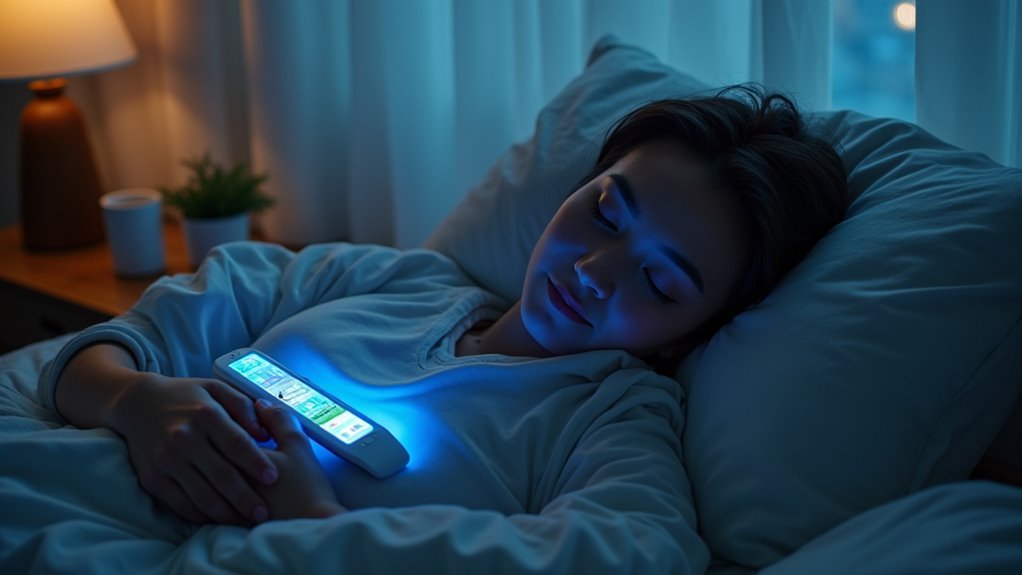
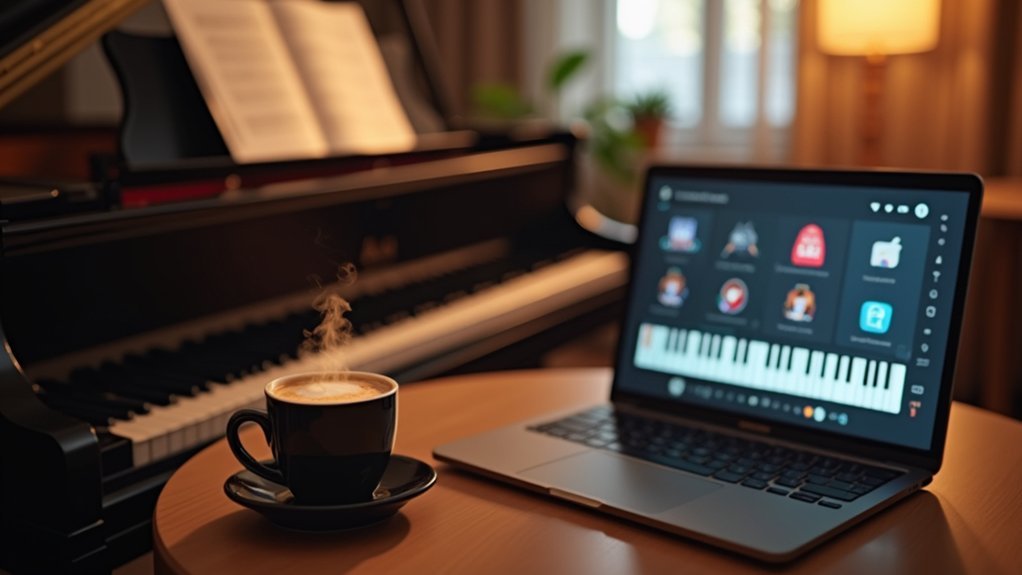
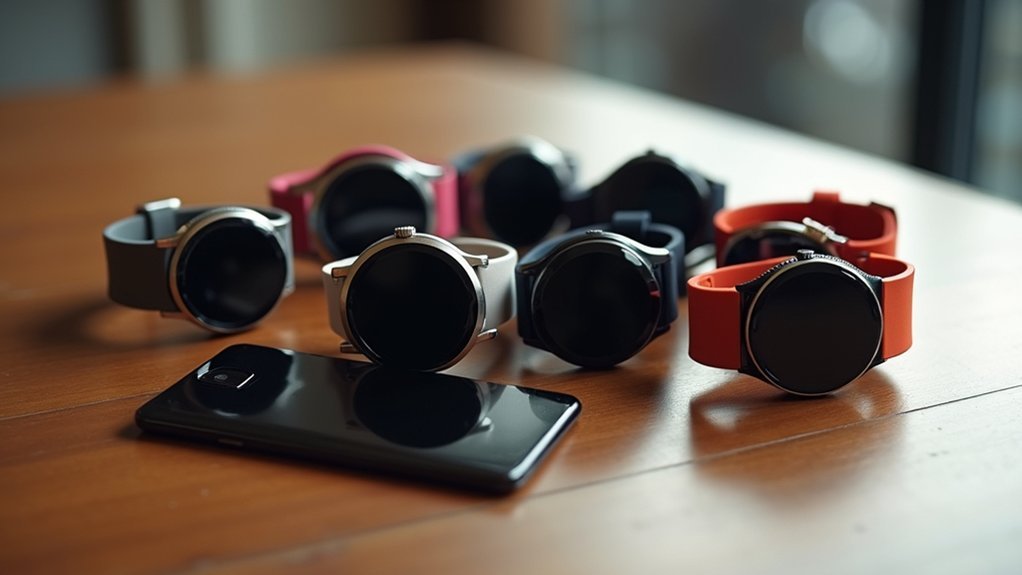
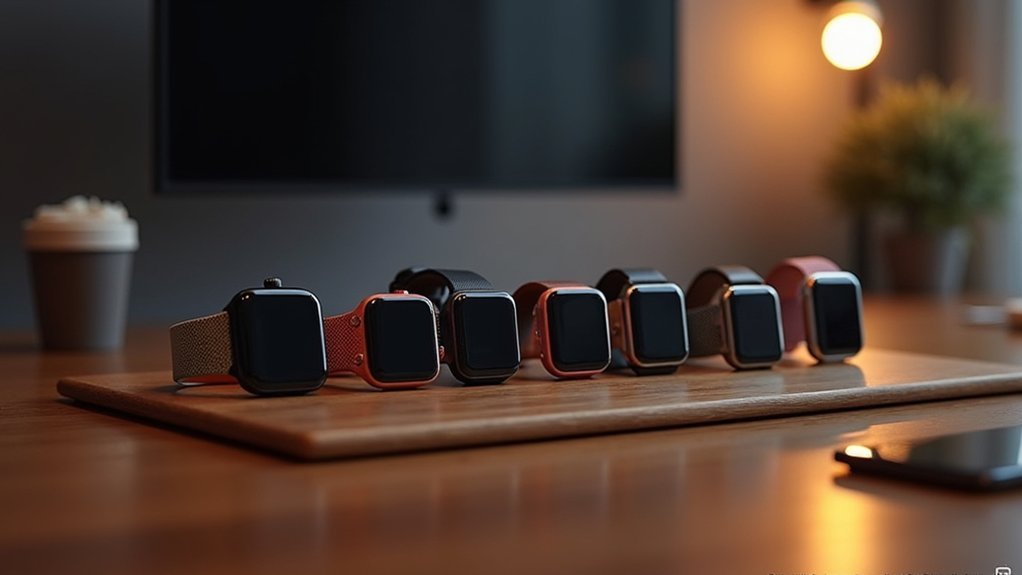
Leave a Reply